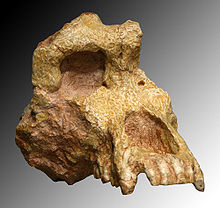Ouranopithecus
Ouranopithecus ("cesur maymun"), 9.6 ila 7.4 milyon yıl önce yaşamış, O. macedoniensis ve O. turkae adlı iki tür tarafından temsil edilen soyu tükenmiş bir Avrasya'lı büyük insansı maymun cinsidir.[1][2]
| Ouranopithecus | |||||||||||||||||||||
|---|---|---|---|---|---|---|---|---|---|---|---|---|---|---|---|---|---|---|---|---|---|
 | |||||||||||||||||||||
| Biyolojik sınıflandırma | |||||||||||||||||||||
| |||||||||||||||||||||
| Türler | |||||||||||||||||||||
| Sinonimler | |||||||||||||||||||||
| |||||||||||||||||||||
Sistematik
değiştirO. macedoniensis'in diş ve yüz anatomisine dayanarak bir dryopithecine olduğu öne sürülmüştür. Ancak, Ponginae ile daha yakından ilişkili olma ihtimali yüksektir.[5][6] Bazı araştırmacılar, O. macedoniensis'i insanların ve diğer büyük insansı maymunların son ortak atası[7] veya australopitesinlerin ve insanların öncüsü[8] olarak düşünür, ancak bu çok tartışmalıdır ve geniş çapta kabul görmemektedir. O. macedoniensis'in, bazı erken homininlerle (ön sinüs ve alındaki bir boşluk gibi) türetilmiş özellikleri paylaştığı doğrudur, ancak bunlar yakından ilişkili türler değildir.[9] Sinonimliği destekleyecek yeterli veri olmamasına rağmen, Graecopithecus freybergi ile[10] simonim olabileceği öne sürülmüştür.[11]
Ayrıca bakınız
değiştirKaynakça
değiştir- ^ a b de Bonis (1977). "Les primates hominoides du Vallésien de Macédoine (Grèce). Étude de la machoire inférieure". Geobios. 10 (6): 849-855. doi:10.1016/s0016-6995(77)80081-8.
- ^ a b Gulec (2007). "A new great ape from the lower Miocene of Turkey". Anthropological Science. 115 (2): 153-158. doi:10.1537/ase.070501.
- ^ "Fossilworks: Graecopithecus". fossilworks.org.
- ^ "Fossilworks: Graecopithecus". fossilworks.org. 20 Temmuz 2020 tarihinde kaynağından arşivlendi. Erişim tarihi: 19 Haziran 2021.
- ^ Alba (2010). "Enamel thickness in the middle Miocene great apes Anoiapithecus, Picrolapithecus and Dryopithecus". Proceedings of the Royal Society B: Biological Sciences. 277 (1691): 2237-2245. doi:10.1098/rspb.2010.0218. PMC 2880156 $2. PMID 20335211.
- ^ Begun (2005). "Relations among great apes and humans: New interpretations based on the fossil great ape Dryopithecus". American Journal of Physical Anthropology. 37: 11-63. doi:10.1002/ajpa.1330370604.
- ^ de Bonis (1990). "New hominoid skull material from the late Miocene of Macedonia in Northern Greece". Nature. 345 (6277): 712-4. doi:10.1038/345712a0. PMID 2193230.
- ^ de Bonis (2004). "Ouranopithecus and dating the splitting of extant hominoids". Comptes Rendus Palevol. 3 (4): 257-264. doi:10.1016/j.crpv.2004.04.002.
- ^ de Bonis (1981). "Dental metric variation in early Hominids comparison between Australopithecus afarensis and Ouranopithecus macedoniensis". Comptes Rendus des Séances de l'Académie des Sciences. Serie III Sciences de la Vie. 292: 263-266.
- ^ Andrews (1984). "The phylogenetic position of Graeceopithecus freybergi Koenigswald". Courier Forschungsinstitut Senckenberg. 69: 25-40.
- ^ Koufos (2005). "The late Miocene Hominoids Ouranopithecus and Graeceopithecus. Implications about their relationships and taxonomy". Annales de Paléontologie. 91 (3): 227-240. doi:10.1016/j.annpal.2005.05.001.
Dış bağlantılar
değiştir- Wikimedia Commons'ta Ouranopithecus ile ilgili çoklu ortam belgeleri bulunur
- Vikitür'de Ouranopithecus ile ilgili ayrıntılı taksonomik bilgiler bulunur.
- İnsan Zaman Çizelgesi (Etkileşimli) 17 Temmuz 2017 tarihinde Wayback Machine sitesinde arşivlendi. – Smithsonian, Ulusal Doğa Tarihi Müzesi (Ağustos 2016).